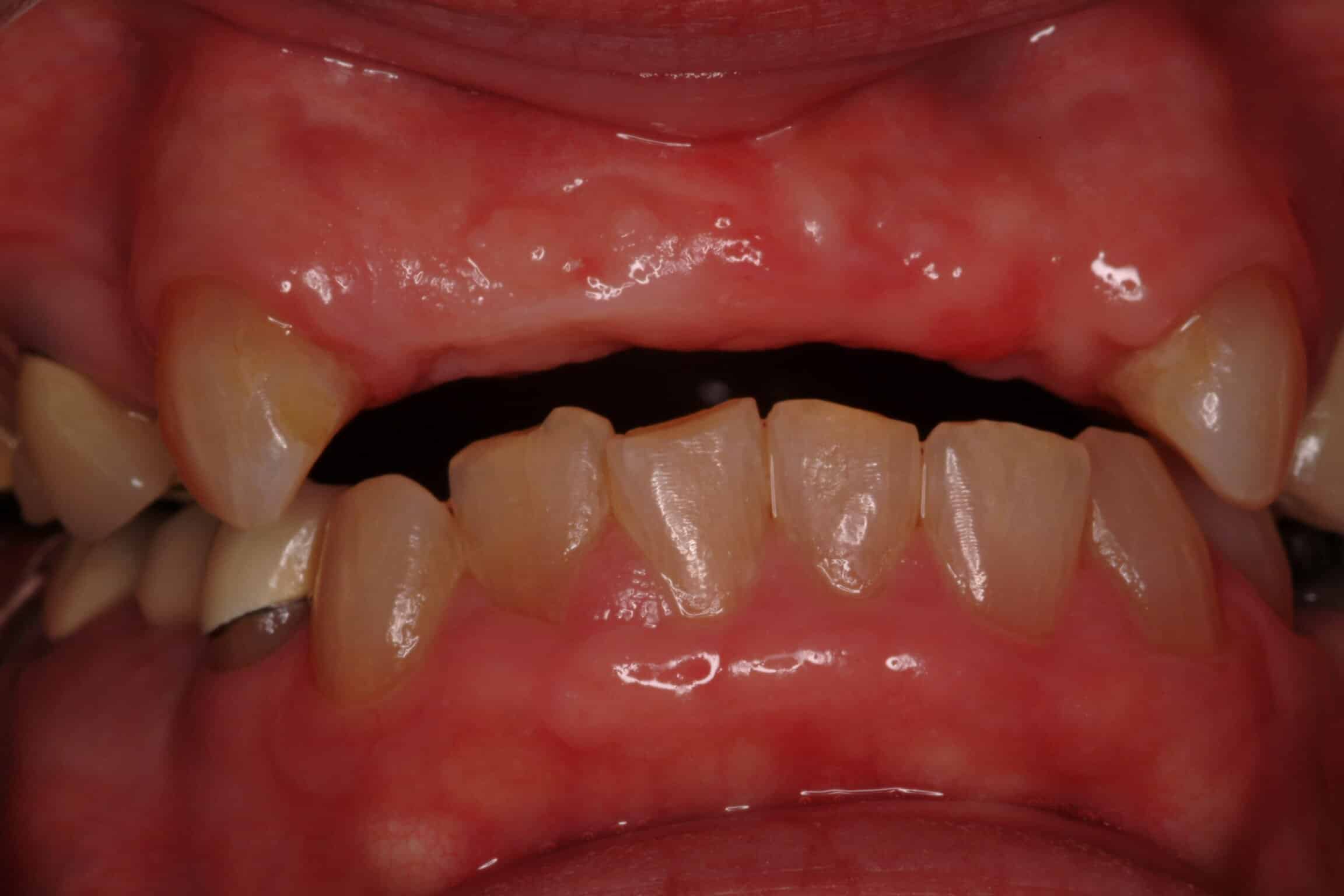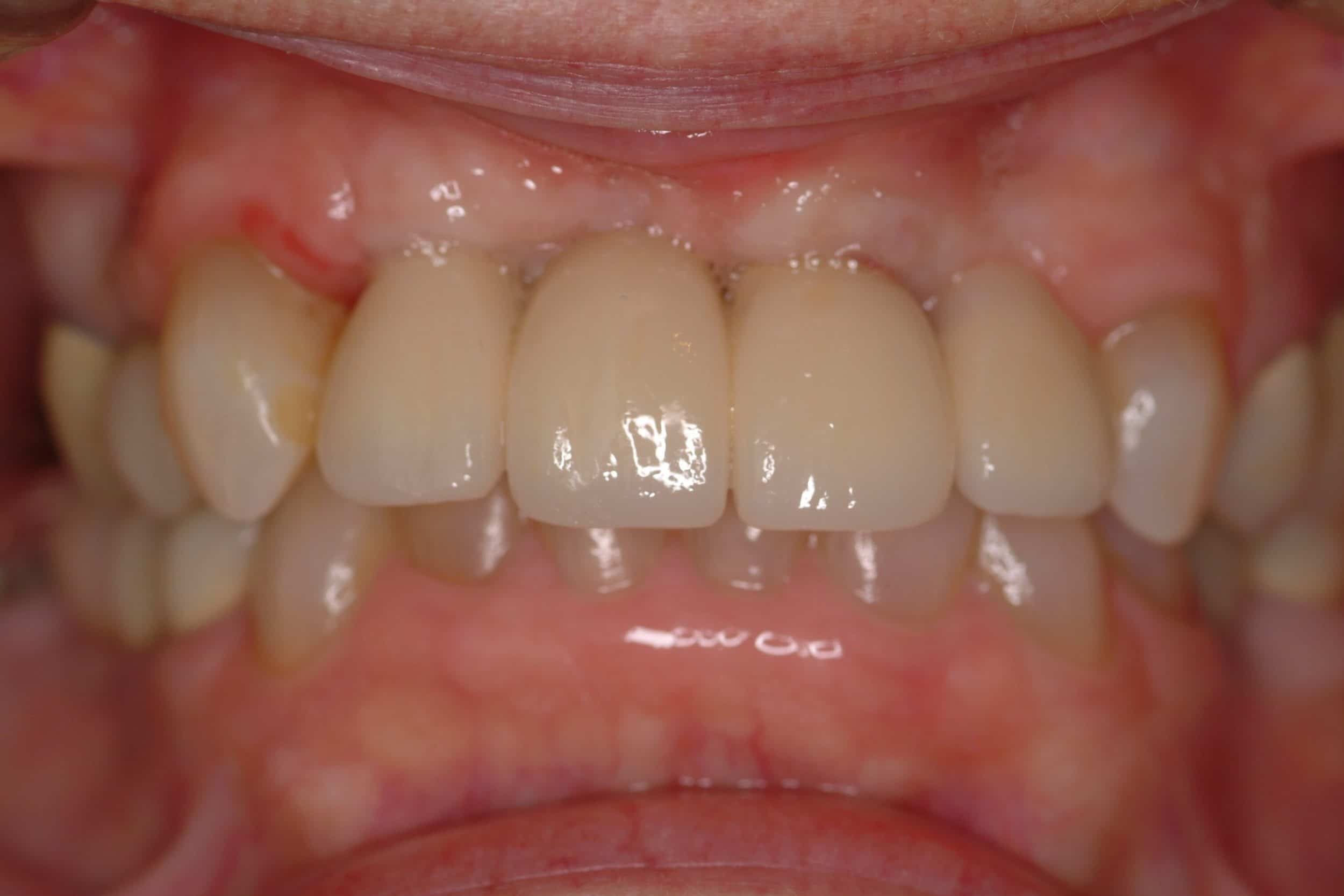Dental Implant Before and After


What Are Dental Implants?
Dental implants are titanium anchors implanted into the jawbone that holds replacement teeth in place. The root of the implant sits in the jawbone beneath the gum line and the visible tooth, or crown is attached to the root. The jawbone grows around the implant, making it a part of the jaw. Next, a post, called the abutment, is placed onto the implant, with an artificial tooth (called a crown) atop that. Implants look and feel much like natural teeth. They support individual artificial teeth, bridges, and dentures.
When are Dental Implants Needed?
Dental implants the best solution for a missing tooth or teeth. Because the actual implant fuses into the jawbone, implants function exactly like your natural teeth allowing the user to eat any foods without concern. Plus, caring for an implant is no different than a regular tooth. It is possible to restore your smile with dental implants.

Why Choose Dr. Holbrook
Dr. Holbrook is an expert in all phases of implant dentistry. This may include replacing a single tooth with a single implant, replacing a series of missing teeth with an implant-supported bridge, or replacing a full set of teeth with implant-supported dentures. Regardless of your situation, we can make implants a part of a healthier oral future.
Am I a Candidate for Dental Implants?
Dental implant patients are adults of all ages. Implants may be the right choice for anyone missing one, multiple, or even all of their teeth due to injury, defects, disease or decay. They can even be an option for adolescents once the jaw stops growing, typically around 16 for girls and 18 for boys.
If you answer “yes” to one or more of these questions, dental implants may be an option for you.
- Do you have one or more missing teeth?
- Do you have a bridge that needs to be replaced?
- Do your dentures affect your quality of life by slipping, clicking or keeping you from eating what you want?
- Do you have bite problems or pain because of a missing tooth?
- Do you want a treatment option for missing teeth that provide a more permanent, long-term solution?
Dental Implant Before and After
Types of Dental Implants
The dental implant, typically made of titanium, is placed into the jawbone and fuses or integrates with your natural bone. The dental implant forms the stable and sturdy base for your replacement teeth.
For a Single Tooth
– There is no better, long-lasting option for restoring a missing tooth than a dental implant fitted with a crown.
For Multiple Teeth
– Replacing multiple teeth using dental implants with individual crowns or with an implant-supported fixed bridge gives your teeth a level of fit, feel and functionality that is not possible with other treatment options.
For All Teeth (Full Arch)
– Traditional replacement of a complete set of upper or lower teeth (arch) using a dental implant is completed over multiple visits.
Dental Implants Procedure
Teeth restored with dental implants look, feel and function just like natural teeth, dental implants differ from traditional dentures. You brush, floss, and visit your dentist for regular check-ups and cleanings, same as you would care for a natural tooth.

The process is often completed over multiple visits:
- Consulting and planning, including initial exam, imaging of your teeth, questions about your dental and medical history, and discussion of your treatment options.
- Placement of the dental implant(s). The dental implant, usually a cylindrical and/or tapered post made of titanium, is placed surgically into the jawbone.
- Placements of the abutments or connectors placed on or built into, the top of the implant to help connect your replacement teeth if needed. Additional connecting devices needed to attach multiple replacement teeth to the implants also may be placed at this time.
- Placement of custom-made individual replacement tooth (or teeth) or an implant-supported fixed bridge or overdenture.
What is Recovery Like?
As you heal, your implant will fuse with your natural jawbone. Temporary teeth can be placed while the dental implant integrates with your natural bone. This healing process can take weeks to months while you proceed with your everyday life in between appointments.
When Can I Return To Work?
Most people return to work the next day, and any discomfort can typically be treated with commonly used pain medication.
Dental Implant Techniques
There are multiple techniques for preparing and placing dental implants:
Bone Grafting
Bone grafting is a safe and highly successful procedure that involves “building up” or adding bone to the jaw by using your own natural bone from another location and/or by using a donor, processed, or synthetic bone materials.
Bone grafts are often performed in the implant dentist’s office using local anesthesia to numb the areas that will be involved.
After the procedure, you will usually be given antibiotics, pain medication if needed, and an antibacterial mouthwash.
Your implants will be placed after the grafted bone has fused or become a strong, integrated part of the existing bone. The integration may take three or more months, depending on the location of the graft and the density of the bone.
Sinus Lift
A sinus lift can also be referred to as a sinus augmentation or sinus elevation. Upper back teeth are amongst the most difficult to restore. When the back teeth in the upper jaw are missing the sinus cavity becomes larger as the natural bone deteriorates over time.
A sinus lift, also called sinus augmentation, is a bone augmentation procedure for patients who have insufficient natural bone in this area for dental implant placement. The procedure involves adding bone below the sinus so that an implant can be placed. The procedure does not affect speech, intonation, or cause sinus problems.
After the bone has been given time to develop, usually for approximately 4 to 12 months, dental implants can be placed.
Ridge Expansion
Ridge expansion is also referred to as ridge modification. If the jaw isn’t wide enough to support implants, bone graft material can be added to a small ridge, or space, that is created along the top of the jaw. In some situations, implants can be placed right after a ridge expansion. Other situations require approximately 4 to 12 months to ensure that the ridge has fully healed first. Ridge expansion also can be used to correct an unattractive and difficult-to-clean indentation that can occur in the jawline near missing teeth.
Alternatives To Dental Implants
Dr. Holbrook offers the following dental implant alternatives:
Immediate Load Dental Implants
Immediate Load Dental Implants also called “same day implants” allow placement of a temporary tooth (crown) during the same appointment as a dental implant placement. The long-term custom crown will be placed in about three to six months. The procedure is best for patients who have enough natural bone and implants that are secure enough to support immediate placement and pressure on the new temporary tooth.
Mini Implants
Mini dental implants (MDIs), are sometimes referred to as small diameter or narrow diameter implants (SDIs or NDIs). These are dental implants that are smaller than the most commonly used dental implant sizes. They are placed through less-invasive techniques and measure less than 3 millimeters in diameter. Standard implants are slightly larger, usually 3.25-5 millimeters in diameter. Mini implants are often used to secure a complete lower or loose denture and in patients who are not candidates for traditional dental implant surgery.
All-on-4
All-on-4 is an alternative approach to place a full arch (top or bottom set) of fixed, replacement teeth. The All-on-4 concept involves placing implants in available bone thereby avoiding the need for bone grafting. Special abutments allow a temporary set of replacement teeth to be placed the same day and used with a modified diet while gum tissues heal and the implants integrate with natural bone. After about six months, the final teeth are then placed and the patient is able to resume a normal diet.
The All-on-4 approach involves multiple appointments, typically including one or two consultation and planning visits, one to place the dental implants and temporary teeth, check-ups during the six month healing period, and another appointment to place the replacement teeth.
How Long do Dental Implants Last?
The success rate of dental implants is around 95 percent. They are remarkably durable and long lasting. In many cases, the implant can last the remainder of the patient’s life. All that is required is normal, good home hygiene.
Choosing Your Implant Dentist
Who you choose to restore your missing teeth is just as important as the technique they use. Creating healthy smiles using the best restoration method for missing or damaged natural teeth requires the care of a dental implant expert who is specially trained and skilled in implant dentistry.
Consider Dr. Steven Holbrook, an experienced Implant Dentist, for your Dental Implants.
The Benefits of Dental Implants
Dental implants offer a range of benefits that make them an excellent choice for tooth replacement.
- Permanent and Long-Lasting: Unlike traditional dentures or bridges, dental implants are designed to last a lifetime with proper care. The titanium post fuses with the jawbone, creating a strong and durable foundation that does not require frequent replacements.

- Improved Chewing and Speech: Since dental implants function like natural teeth, they allow patients to eat various foods without discomfort. Unlike removable dentures, which can slip or shift, implants remain securely in place, eliminating speech issues that can arise from ill-fitting dentures.
- Prevents Bone Loss and Maintains Facial Structure: Tooth loss can lead to jawbone deterioration over time. Because dental implants stimulate the bone, they help prevent bone loss that often occurs with missing teeth. This maintains the face's natural structure and prevents a sunken appearance that can occur with prolonged denture use.
- Natural Appearance and Feel: Implants are custom designed to match your natural teeth' shape, size, and color. This seamless integration ensures a natural-looking smile that blends in perfectly.
- No Slipping, Irritation, or Adhesives: Traditional dentures can shift when speaking or eating, causing discomfort and embarrassment. Since implants are permanently fixed, they eliminate the need for adhesives and offer a worry-free solution for everyday activities.
- Simple Maintenance: Caring for dental implants is as easy as maintaining natural teeth. Regular brushing, flossing, and routine dental visits help keep implants healthy without needing special cleaning solutions or soaking as required for dentures.
Dental Implants vs. Dentures: Which Is Right for You?
While both options restore the appearance of missing teeth, they differ significantly in terms of function, comfort, and longevity. Dental implants offer superior stability and durability compared to dentures. Because implants fuse with the jawbone, they provide a permanent solution that does not require periodic replacement. On the other hand, dentures typically last between five and ten years before needing adjustments or replacements due to natural bone loss and wear. Additionally, dentures rest on the gums and sometimes irritate, while implants feel like natural teeth, providing comfort and confidence in everyday activities.
One of the biggest advantages of dental implants is their ability to preserve bone health. Dentures do not stimulate the jawbone, leading to bone deterioration over time. As the jawbone shrinks, dentures may become loose and require relining to maintain a secure fit. Dental implants, by contrast, promote bone growth and prevent the facial structure from collapsing, offering long-term oral health benefits.
However, dentures may be a more practical option for patients who have experienced significant bone loss and are not candidates for implant placement without bone grafting. Additionally, dentures have a lower upfront cost, making them a more budget-friendly solution in the short term. Ultimately, the best option depends on a patient’s oral health, lifestyle, and long-term goals.
Post-Procedure Care for Dental Implants
Proper aftercare is essential for implant success. Patients should avoid touching the implant site during the first 24 hours and refrain from consuming hot liquids or engaging in strenuous activities. Pain management can be achieved with prescribed or over-the-counter medications, and a soft diet is recommended for the initial healing phase. Gentle rinsing with a saltwater solution can aid in healing, while regular brushing and flossing help maintain oral health. Attending follow-up appointments ensures that the implant integrates properly and functions as intended.
Schedule A Dental Implant Consultation in Albuquerque!
If you are interested in dental implants and would like to see if you are a good candidate, contact us at 505-881-1159 to schedule a consultation at our office in Albuquerque, NM. You can fill out the appointment request form in our contact page, and we will help you set up your meeting with Dr. Holbrook. Our practice looks forward to serving you!








